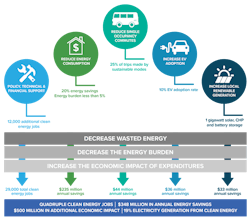Energy an Important Factor as Central Ohio Prepares for Its Future
Central Ohio has been a hotbed of forward-thinking activities, seeing a critical mass of cutting-edge projects occurring all at the same time across the region. Smart Columbus, charged with intelligently connecting and electrifying transportation in the city, was established soon after the U.S. Department of Transportation named Columbus the winner of its Smart Cities Challenge in 2016.
The U.S. Route 33 Smart Mobility Corridor was conceived to begin testing autonomous freight vehicles and technology in real-world applications. As these were actualizing, the Mid-Ohio Regional Planning Commission (MORPC) spearheaded the Midwest Connect hyperloop route, considering the feasibility of connecting Chicago, Columbus, and Pittsburgh with the emerging technology. It was one of the 10 global winners in the Virgin Hyperloop One Global Challenge.
There is no question that Central Ohio is growing. The most recent estimates from the MORPC put Central Ohio’s population at 2.4 million residents, and the region’s population is projected to grow to three million by 2050. Providing for the energy resources needed to support this exceptional growth will again take significant forward thinking and direction. Recognizing this, the Franklin County Board of Commissioners enlisted the MORPC to conduct the Franklin County Energy Study.
The Franklin County Energy Study uses 2015 as a baseline for energy production, consumption, expenditures and emissions, and incorporates utility data provided at the ZIP-code level. Although Franklin County energy use is on par or better than national averages on a per capita basis, only a portion of this energy is put to useful work. The study found that 69% of energy used in Franklin County is wasted because of inefficiencies in delivering electricity through the grid, inefficiencies in its end-use, and reliance on the internal combustion engine for transportation. Over US$3 billion of consumer spending went toward wasted energy in 2015.
Because of the reliance on energy from outside of Franklin County, more than 87% of energy expenditures do not have a direct economic impact in areas within the county. Out of over US$4 billion in total expenditures, only US$555 million had a direct effect in Franklin County as spending on salaries, supplies, raw materials, and operating expenses. More than US$3.8 billion left the county as payment for imported fuels, electricity, and other expenses related to the construction and maintenance of the energy network.
The residential energy burden was another metric used to analyze the current state of energy in Franklin County. It is common to assume that 5% of income will go toward home energy bills. Nationally, the average energy burden hovers around 3.5%. The study found five communities that spend 6 to 10% of the residents’ income on heating and powering their homes. One community spends over 10%, which puts these residents at an extreme disadvantage to be able to afford other essentials and hampers their economic growth.
The MORPC also developed a set of recommendations for the county to address the issues identified in the study. Included in the recommendations are ambitious, yet achievable, goals for improving Franklin County’s energy network by 2030. Three of these goals deal specifically with energy production and consumption.
The MORPC identified the potential to reduce residential and commercial energy consumption by 20%, with an additional goal of ensuring that the average energy burden does not rise above 5% for any ZIP code within the county. These improvements would lead to US$235 million in annual savings for residents and businesses. They would also reduce the annual outflow of expenditures by 5.3%.
In line with the goals of Smart Columbus, the recommendations included a goal of increasing electric vehicle adoption to 10% of the market. This would have the impact of reducing energy expenditures within the transportation sector by US$36 million per year. Not factored into this are the health benefits associated with reducing emissions and street-level pollution.
The MORPC also identified the potential to incorporate 1 GW of capacity additions within Franklin County. Myriad scenarios were developed, which included solar photovoltaic, combined heat and power, and battery storage. It was found that any scenario that included a maximum of 50% utility scale solar would not only be cost effective, but would also increase the local economic impact of energy expenditures by 6%.
In total, all of the recommendations are expected to keep an additional US$509 million of energy expenditures within the local economy every year and acquire up to US$348 million in annual consumer savings for Franklin County residents and businesses. In addition to the economic impacts of these goals, Franklin County also hopes to address the issues of energy inequality, build a system of resiliency, and ensure a sustainable future for generations to come.
Since the release of the Franklin County Energy Study in 2018, the residential energy burden metric led to a significant coalescing of local initiatives and garnered support nationally. For the Bloomberg American Cities Climate Challenge, the city of Columbus developed an intervention of increased energy audits, efficiency measures, and job training within the six energy-burdened communities identified in the study.
As this work was beginning, the Community Energy Savers program, a joint initiative between AEP Ohio, Columbia Gas of Ohio, and the Department of Neighborhoods, was reinvigorated with a renewed focus on the neighborhoods identified by the energy burden metric. With the success of this one metric, the MORPC is beginning to look at further opportunities, not simply to measure, but to bring together multiple organizations through common causes as the region moves toward a sustainable future.
The Franklin County Energy Study and the recommendations can be found on the MORPC’s website here.
About the Author
Jon-Paul d’Aversa
Jon-Paul d’Aversa, AICP, is a senior energy planner at Mid-Ohio Regional Planning Commission.

